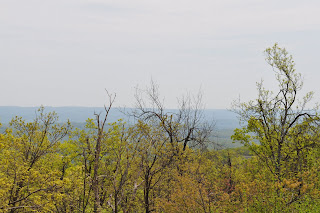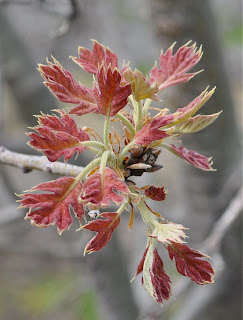
On the way we stopped at a strip mall and found all the cherry trees were missing copious numbers of leaves.


It is quite odd, especially in such young trees, for them to expend so much energy into reproduction rather than growth. It is a signal the tree recognizes it is dying.


The seeds and flowers vary in color, just as do autumn leaves, and the spring landscape has been less a typical pale green and more a range of intriguing hues of pink, red, yellow, orange and ivory.


It seems so old-fashioned to have a barbershop named Johnny's with a bench next to it. I was expecting to run into Ward Cleaver.
It was not surprising to me to see the trees in the town had bare branches, another sign of terminal decline.


The wisteria was blooming, but the rhododendron leaves were damaged. This is the sort of stippling from damaged stomata that is characteristic of exposure to toxic tropospheric ozone, even in remote places far from the original source of emissions.


Susan from the Boston area noted recently on her facebook page: "Richard Heinberg talk: I learned tonight that one gallon of oil is derived from 100 tons of ancient plant matter. This matter was converted from carbohydrates to hydrocarbons at two specific periods in the past, 9 million and 15 million years ago, when rampant algae blooms were consumed by plankton, sunk and compressed into the ocean."


How ludicrous that we ever imagined we could unleash such immense amounts of concentrated energy into the ecosystem without instigating an existential threat to all the species that adapted over millennia within a relatively stable climate and environment. No wonder we have insane and record-trouncing rainfalls and resultant floods like that one happening in Tennessee.

A photograph cannot do justice to this tree, the most astonishing yet.


A photograph cannot do justice to this tree, the most astonishing yet.

Such density seems highly abnormal, and is counterproductive from the standpoint of what is healthy for the organism. But then trees are more noble and wiser than humans, it would appear.
I wanted to go to High Point because I thought the panoramic views of the Catskills to the north, and the Poconos to the west, would constitute a very effective demonstration of the amazing colors in the landscape this spring.


From the peak there is a vantage of three states simultaneously, New York, of course New Jersey, and Pennsylvania, across the Delaware River.


There are wild blueberries growing in the crevices of the rocks. It's amazing how tenacious plants are!


But the treeline is ominous, no matter which part of this almost 16,000 acres we traversed. This is the terrestrial equivalent of the bleaching of the coral reefs. The foundation for the ecosystems is collapsing and with it will go all other dependent species...including, eventually, us.


I loved the lichen patterns on the rocks, even though it is proliferating as a harbinger of tree decline as it breaks down the dying wood.


The property was dedicated as a park in 1923, almost a century ago, so I fully expected to see lots of mature trees with big canopies and large trunks. Damaged, no doubt, but at least some remnants of a grand forest.
I was truly shocked and disappointed to see only extremely small and spindly specimens.
As I hiked around I assumed for a while that perhaps the woods must be so scrubby because of the elevation...
until I saw many of the largest trees marked for removal with blue paint. This one has had half taken away already, and the remaining trunk is next to go.


That's when I realized the Park Service is obviously continually removing the dead wood and dying trees, and so the big old trees which succumbed from more years of exposure to rising levels of ozone have already vanished, leaving behind only younger, smaller growth.


The understory (if it can be called that - there is no story!) looks like a grassy meadow but is comprised of a thick layer of baby trees, mostly oaks and maples, which are covered with seeds and flowers making this a colorful carpet.


It would all be quite beautiful if it were't an ominous sign of decline.
I can't help thinking that if people only understood that we are about to erase trees from the earth
we would stop dumping 70,000 tons of CO2 every day - and who knows how much nitrous oxide, sulphur dioxide, and acetaldehyde - into the air!
There are picnic tables scattered througout the park. When the trees no longer shade them, they will become unbearably hot in the summer.


One of the scariest things was seeing my own prediction come true - leaves are already wilting and shriveling before they even grow out all the way! And no, there was no evidence of insects.

Several specimens had leaves that had completely curled up.


Several specimens had leaves that had completely curled up.

It could be of fungal or bacterial origins, preying on trees that are weakened. Then too, ozone becomes worse as temperatures rise, and as can be seen from all the flowers that bloomed weeks early, this has been a very warm spring.


This grouping of trees on the ascent to the monument at the summit has all the symptoms of BALDing syndrome (Bark Atrophy Lichen Decline).


According to the Museum of Science in Boston, this lichen is large enough to be several hundred years old, which is of course preposterous. Something in the air is contributing to unprecedented lichen spread. I believe it is nitrogen in some form or other.


Also several in this copse have holes where the trunk contacts the ground.



Also several in this copse have holes where the trunk contacts the ground.

which would explain why the crowns are so devoid of leaves.
Just like the trees, bees are dying in huge numbers and once again no one knows why. The experts consider disease, mites, and pesticides. No one is looking at air pollution as the cause for the alarming decline of bee populations, either. Why doesn't some scientist raise some bees in clean air, and also air such as we are breathing today, and compare?!


Here are some excerpts from the article: "Flowering plants require insects for pollination. The most effective is the honeybee, which pollinates 90 commercial crops worldwide."
"As well as most fruits and vegetables – including apples, oranges, strawberries, onions and carrots – they pollinate nuts, sunflowers and oil-seed rape."


"Coffee, soya beans, clovers – like alfafa, which is used for cattle feed – and even cotton are all dependent on honeybee pollination to increase yields."


I had to put in a picture of this ridiculous monument to prove I was here. At 220 feet it is an unabashedly, er, phallic memorial to honor war veterans, donated by the Colonel and Mrs. Kuser.


This toothless fellow became enraged at the machine that wasn't working yet kept swallowing his quarters, and opined in colorful language that it was representative of the state of the world in general.


High Point Park seems to attract an odd cast of characters, many of whom have tattoos. Is this a case of owner/dog resemblance? Apparently, academics actually study this question!


"Their extinction would mean not only a colourless, meatless diet of cereals and rice, and cottonless clothes, but a landscape without orchards, allotments and meadows of wildflowers – and the collapse of the food chain that sustains wild birds and animals."


Back to the flatlands, I spotted this pair of huge oaks which must be at least 300 years old. I climbed through thickets of the thorny multiflora to get near them, they are so magnificent. I have no idea how they escaped the clear cutting that has pillaged these parts more than once, but they are in a nature preserve. Perhaps they were part of an old estate and the original home is long since demolished. The one above is in slightly better shape than its neighbor.


After hiking around in - oh, did I forget to mention, it was a sweltering - NINETY SIX DEGREES FAHRENHEIT??, we stopped for a nice cold beer in a sort of funky obscure bar where I found this evocative old photograph on the wall. How proud we are of plundering the natural world!!































I've been looking at many other pictures of High Point State Park on the web, and I have to say that it looks pretty unhealthy in your pictures compared to the others I've seen. It's difficult to compare, given that the other pictures don't tend to have any indication of which year they were taken, or which month.
ReplyDeleteI have a suggestion: When you go to somewhere like that, which has obviously been photographed thousands of times over the years, try to find one or two pictures that you can pin down to exact dates from previous years before you go, and then see if you can take similar pictures when you're there, for comparison. It should be easier for somewhere famous and well-visited like that - I've seen lots of pictures with the monument in, or taken from the monument, for example. Just a thought...
All the best,
John.
John,
ReplyDeleteThat is an excellent suggestion. A quick search yielded this collection of photos:
https://www.stateparks.com/high_point_photography.html
In which the trees look pretty terrible as well! I will try to find out when the pictures were taken. The first two, for example, have pines with serious damage. The picnic table scene towards the end has fallen logs on the ground. I am very curious as to how recently these images reflect the park!